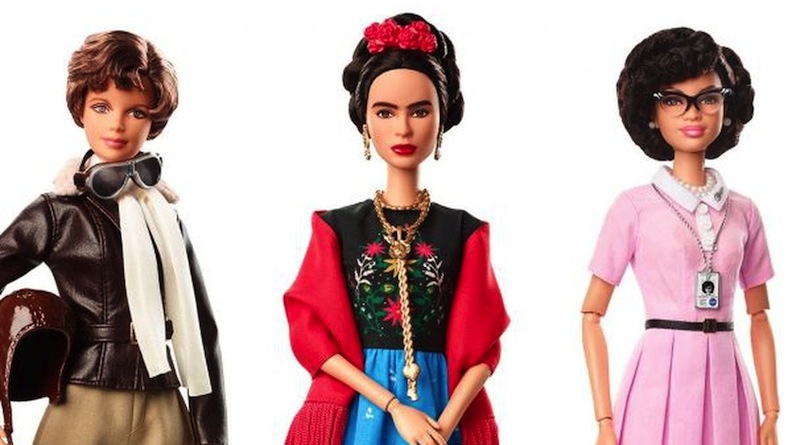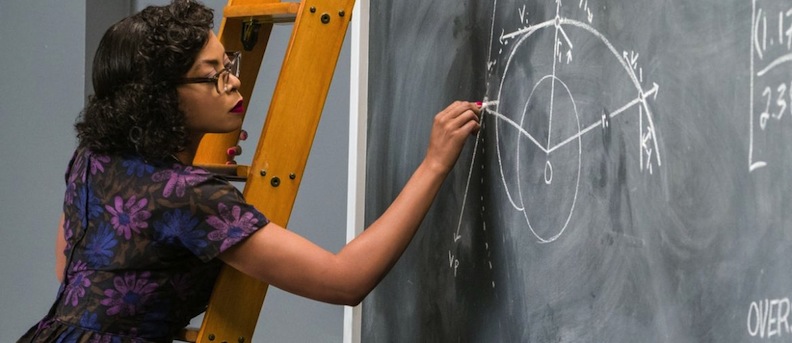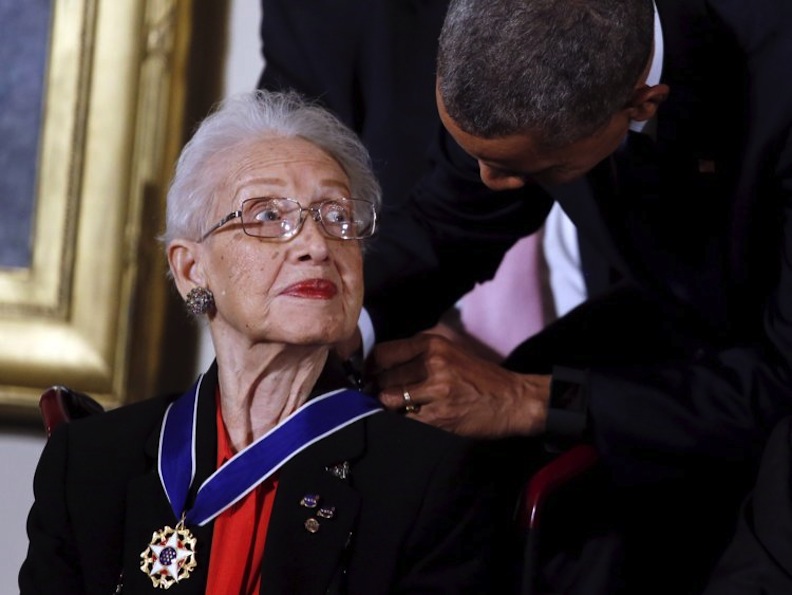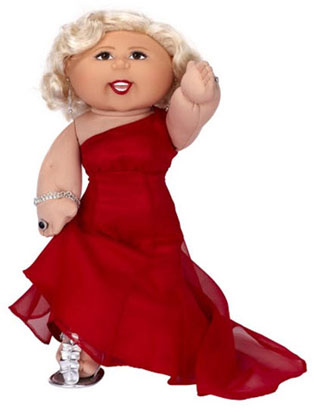
Katherine Johnson, no longer a hidden figure. The mathematician is one of Barbie’s Inspiring Women dolls.
The three dolls that Mattel unveiled as part of its Barbie Inspiring Women series represent a trio of female pioneers who hailed from different cultures, educational backgrounds, societies, and — most poignantly — opportunities. These dolls (Amelia Earhart, Frida Kahlo, and this week’s spotlight, Katherine Johnson) all made names for themselves, but each one had to work against cultural barriers and institutional prejudices. Earhart had to prove that she — a white woman — could navigate alongside the big boys. Kahlo had to emerge from illness and injury to showcase her surrealistic paintings in a heavily male-centric art world. Katherine Johnson, an African-American mathematician, had to fight racial prejudice, gender expectations, corporate bureaucracy, and historical oversights. It’s remarkable that it took so long for Johnson’s name to become known by the general public, and, quite luckily, the Katherine Johnson doll has emerged on the eve of her 100th birthday.
Born Aug. 26, 1918, young Katherine Coleman was a whiz at arithmetic. Her hometown in Greenbrier County, West Virginia, did not provide public education for black children past the eighth grade. Despite her precocious ability to do high-school-level math while still in elementary school, Katherine was expected to graduate from primary school and take a job in the service industry, work as a domestic, or perhaps grab a clerical job at a local business. If she showed proper decorum and morals, maybe she’d be lucky enough to be assigned a position as a teacher in a black school’s classroom. Katherine, however, was not a typical child, and her parents were well aware of her potential.

The first three dolls of Mattel’s Barbie Inspiring Women — the trio made waves in the skies, on earth, and way beyond.
Proving from an early age that she was destined to be an inspiring woman — and a logical choice for the Inspiring Women series of Barbies — Katherine was plucked from her neighborhood school. Her parents lobbied for her to be sent to a gifted school located on the campus of West Virginia State, one of America’s historically black colleges. Her parents saw that Katherine and their other children deserved special attention and were remarkably bright and talented. Luckily for Katherine and her siblings, they had parents who were intelligent and motivated. The Coleman family was determined that their offspring would used schooling and education as a springboard for success. This belief of being able to do more, and be more, helped to launch Katherine Johnson into her improbable, middle-age success.
After graduating high school at the age of 14, Katherine had worked as a teacher in the segregated, black school system of West Virginia. She married her first husband, James Goble, and raised a family, bowing out of the work force, following the traditional customs and expectations for women all across America in the 1940s. Life, though, held a different trajectory for Katherine Johnson — an amazing trajectory both figuratively and literally. In 1952, she learned that the National Advisory Committee for Aeronautics (NACA) was looking for mathematicians.

NASA’s official portrait photo of Katherine Johnson (Courtesy of NASA)
The forerunner of the current NASA, which came into existence in 1958, NACA was a governmental body that was keen to compete with the Russians in the Space Race. To achieve parity, and to advance beyond the Soviets, NACA was an equal-opportunity employer. Their managers wisely believed that calculating figures and computing equations could be done by men and women, blacks and whites. Sadly, though, the working conditions within the NACA building were still segregated. There were separate bathrooms, water fountains, break rooms, and other locales for the black employees. This separation of Americans in the federal workspace had been mandated by President Woodrow Wilson during his administration. (A onetime darling of the Democratic party, Wilson is — little by little — being exposed as a progressive, forward-thinking man globally, but a restrictive and racist legislator at home.)
In 1953, Katherine Johnson began her career at NACA, and then five years later at NASA, as a “human computer.” Her job was to work out the mathematical equations and to unlock the algorithms that mapping out flight paths and return missions required. Working with a pool of other bright and conscientious black women, Johnson made a name for herself as a reliable, quick, and efficient support-staff member. Eventually, though, she showcased that she was more than just an adding machine in a shirtwaist dress. She was able to perceive logistical requirements for safe and speedy space travel; she was able to envision, calculate, and realistically express the orbital paths that rockets required. Johnson proved herself to be an insightful and intelligent mathematician. She became a go-to person for mission specialists and NASA engineers.

Katherine Johnson taking a break from her trajectory calculations (Courtesy of Smithsonian Air & Space Archives)
Throughout her career at NASA, Katherine Johnson was an important part of the space agency’s behind-the-scenes heroes. She was a key component in the 1969 Apollo 11 flight to the Moon. She was one of the lead mathematicians who conjectured and then finalized the astronauts’ flight path. In 1970, she had worked on the calculations for what would become the aborted Apollo 13 mission. She also was heavily involved in the Space Shuttle programs, proposed missions to Mars, and the Earth Resources Satellite.
Katherine Johnson was not a household name, nor were the other African-American women who worked initially as “computers” and then graduated to becoming programmers for digital computers, as well as statisticians and aerospace technologists. Most of their work and accomplishments remained in the shadows, and their contributions were forgotten about and never mentioned. It’s not too much of a stretch to say that it was whitewashed from memory.

The cast of “Hidden Figures,” a 2016 hit: from left to right, Janelle Monáe, Taraji Henson, and Octavia Spencer (Courtesy of 20th Century Fox)
It was the 2016 double blast of a high-profile book by author Margot Lee Shetterly and an award-nominated movie that skyrocketed Katherine Johnson (and fellow NASA workers Dorothy Vaughan and Mary Jackson) into pop culture. The nonfiction book and film “Hidden Figures” followed the triumphs and tragedies, accomplishments and roadblocks, that surrounded these trendsetting, trailblazing African Americans. In the movie version, Oscar winner Octavia Spencer portrayed the NASA supervisor Dorothy Vaughan; singer Janelle Monáe embodied the aspiring engineer Mary Jackson; and TV star Taraji P. Henson played Johnson. All three of these bright and brave women were inspiring, but it was Katherine Johnson that got the Mattel nod of becoming a Barbie Inspiring Woman.

Taraji P. Henson portraying the personal triumphs and professional advancements of Katherine Johnson (Courtesy of 20th Century Fox)
On August 26, 2018, Katherine Johnson turns 100 years old. That is a remarkable achievement in a life that is filled with marvelous and meaningful moments. Among these accomplishments: from 1971 to 1986, she was the recipient of several NASA Langley Research Center Special Achievement Awards; from 1998 to 2010, she was granted several honorary doctorates from major universities; in 2016, NASA formally dedicated a brand-new building named the Katherine G. Johnson Computational Research Facility, and a STEM scholarship and educational program has been named in her honor.
In 2015, Johnson was awarded the Presidential Medal of Freedom, bestowed upon her by President Barack Obama. Two years later, in 2017, the Daughters of the American Revolution selected her for their Medal of Honor. The doors to the NASA research facility named in her honor swung open on Sept. 22, 2017.

Katherine Johnson receiving the Presidential Medal of Freedom from President Obama (Courtesy of White House Press Archives)
The Barbie Inspirational Women line of dolls are important because they highlight accomplished people who have furnished inspiration during their time, and have encouraged others to follow in their paths. Even though Katherine Johnson was not as famous during her professional career as Earhart and Kahlo, her presence in the NASA agency helped to erode the barriers that were constructed to separate her from her peers, colleagues, and fellow Americans.
It is a huge irony that while Katherine Johnson and other aerospace technologists — white men and black women — collaborated together to conquer the heavens and beyond, the black women still faced the institutional bonds of second-class citizenry. Johnson ignored the rules and the restrictions at her workplace. She attended meetings, without invitation, where hers was the only black face. Her confidence, instilled in her by her parents decades earlier, motivated her to be in a room where her work was about to be dissected and implemented.

Mattel selected Katherine Johnson as one of their initial Inspiring Women Barbies. She is lauded for her intellect, confidence, ambition, and barrier-breaking achievements.
Katherine Johnson helped to ferry astronauts to and from Earth. She was one of the heroes that ensured their safety and their legacies. Working without fanfare or press coverage, she was one of the early pioneers destroying the racial segregation of federal employees in government workspaces. She truly was an Inspirational Woman from the Earth, to the Moon, and beyond.








